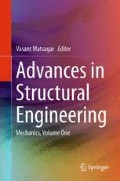Abstract
In the recent past, trend has been shifted towards construction of tall and slender buildings to mitigate the scarcity of land in the busy areas. In today’s scenario threat of enemies and terrorist attack is increasing. A bomb explosion within or immediately nearby a building can cause catastrophic failure of the building, loss of life and injuries to occupants (Dharaneepathy et al. in Comput Struct 54:587–595, 1995 [1]). Therefore consideration of blast load in analysis and design of important structures is essential. The study explores three-dimensional nonlinear dynamic responses of typical tall building under blast loading. The 45 storey symmetric reinforced concrete building is designed for dead, live and wind loads. The influence of the variable blast source distance (30, 40, 50 m) and variable blast source height (8th, 23rd, 38th storey at 30 m ground zero distance) on the lateral load response in terms of peak deflections, accelerations, inter-storey drift and hinge formations were investigated. Performance level of building as per FEMA 273 was also checked for each individual case. Structural response predictions were performed with a commercially available three-dimensional finite element analysis programme using non-linear direct integration time history analyses. Results for buildings with variable blast source distance were compared. Similar study is performed for variable blast source height. A detailed study on the response of blast excited building is presented for 500 kg of TNT placed on ground and in the air. The work mainly focuses on the dynamic response and performance level of building under different cases of blast. The calculation of Blast load on building for all cases is carried out by using IS 4991 (1968) criteria for blast resistant design of structures for explosions above ground. The results revealed that for a tall building, effect of blast decreases as standoff distance increases and there is consequent decrease in the non-linear dynamic response. It has been observed that performance level of building is critical for minimum standoff distance. In case of variable blast source height, explosion created at 23rd floor and 30 m ground zero distance is critical because building will be subjected to more blast force above and below the blast level. It has been observed that the dynamic response is random and not maximum at top storey.
Access this chapter
Tax calculation will be finalised at checkout
Purchases are for personal use only
References
Dharaneepathy MV, Keshava Raot MN, Santhakumarzf AR (1995) Critical distance for blast-resistant design. Comput Struct 54:587–595
Murthy CVR (2007) IITK-GSDMA guidelines on measure to mitigate effect of terrorist attacks on building
Ngo T, Mendis P, Gupta A, Ramsay J (2007) Blast loading and blast effects on structures—an overview. EJSE 7:76–91 (special issue: loading on structures)
Mendis P, Ngo T (2003) Vulnerability assessment of concrete tall buildings subjected to extreme loading conditions. In: Proceedings of the CIB-CTBUH international conference on tall buildings
Jayatilake IN, Dias WP, Jayasinghe MT, Thambiratnam DP (2010) Response of symmetrical tall building with symmetric setbacks under blast loading. J Nat Sci Found Sri Lanka 38(2):115–123
Draganic H, Sigmund V (2012) Blast loading on structures. Tehnicki vjesnik 19(3):643–652
Paz M (2004) Structural dynamics—theory and computation, 2nd edn
Chopra AK (2007) Dynamics of structures—theory and application to earthquake engineering, 3rd edn
Ambrosini D, Luccioni B, Jacinto A, Danesi R (2005) Location and mass of explosive from structural damage. Eng Struct 27:167–176
Luccioni BM, Ambrosini RD, Danesi RF (2004) Analysis of building collapse under blast loads. Eng Struct 26:63–71
ASCE Manual (2010) Design of blast-resistant design in petrochemical facilities, 2nd edn. American Society of Civil Engineers, Reston
IS: 4991-1968 Criteria for blast resistant design of structures for explosion above ground. Bureau of Indian Standards
SAP (2000) Integrated finite element analysis and design of structures. Computers and Structures, Inc., Berkeley
Applied Technology Council ATC-40 (1996) Seismic evaluation and retrofit of concrete buildings, vol 1. ATC-40 Report, Applied Technology Council, Redwood City, California, USA
Federal Emergency Management Agency 273 (1997) NEHRP, Guidelines for the Seismic Rehabilitation of Buildings. Developed by the building seismic safety council for the federal emergency management agency. Washington, DC
FEMA 426 (2003) Reference manual to mitigate potential terrorist attacks against building, providing protection to people and buildings
Author information
Authors and Affiliations
Corresponding author
Editor information
Editors and Affiliations
Rights and permissions
Copyright information
© 2015 Springer India
About this paper
Cite this paper
Qureshi, Z.A.L., Madhekar, S.N. (2015). Response of 45 Storey High Rise RCC Building Under Blast Load. In: Matsagar, V. (eds) Advances in Structural Engineering. Springer, New Delhi. https://doi.org/10.1007/978-81-322-2190-6_37
Download citation
DOI: https://doi.org/10.1007/978-81-322-2190-6_37
Published:
Publisher Name: Springer, New Delhi
Print ISBN: 978-81-322-2189-0
Online ISBN: 978-81-322-2190-6
eBook Packages: EngineeringEngineering (R0)

